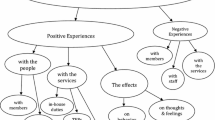Abstract
Client characteristics and their perceptions of the milieu in a psychosocial rehabilitation program were used to predict the clients' level of involvement in the peer-based social network. 81 clients in a psychosocial rehabilitation program participated in the study. The results indicated that client perceptions of higher support and clarity in the staff-client milieu, and being female, were strongly related to higher peer social involvement. Milieu factors were generally more important than client characteristics in predicting client social functioning. The implications of these findings for psychosocial intervention and for research on the social functioning of this population are discussed.
Similar content being viewed by others
References
Angermeyer, M.C., Kuhn, L., & Goldstein, J.M. (1990). Gender and the course of schizophrenia: Differences in treated outcomes.Schizophrenia Bulletin, 16(2), 293–308.
Andreasen, N.C., Swazell, V.W., Flaum, M., Yates, W.R., Arnt, S., & McChesney, C. (1990). Ventricular enlargement in schizophrenia evaluated with computed tomographic scanning: Effects of gender, age and stage of illness.Archives of General Psychiatry, 47(11), 1008–1015.
Avison, W.R. & Speechley, K.N. (1987). The discharged psychiatric patient: A review of social, social-psychological, and psychiatric correlates of outcome.American Journal of Psychiatry, 144(1), 10–18.
Baker, F. & Douglas, C. (1990). Housing environments and community adjustment of severely mentally ill persons.Community Mental Health Journal, 26(6), 497–505.
Bell, M.D., & Ryan, E.R. (1985). Where can therapeutic community ideals be realized? An examination of three treatment environments.Hospital and Community Psychiatry, 36(12), 1286–1290.
Brekke, J.S. & Aisley, R.A. (1990). The client interaction scale: A method for assessing community support programs for persons with chronic mental illness.Evaluation and the Health Professions, 13(2), 215–226.
Brekke, J.S. & Test, M.A. A model for measuring the implementation of community support programs: Results from three sites.Community Mental Health Journal, in press.
Cassel, J. (1976). The contribution of the environment to host resistance.American Journal of Epidemiology, 104, 107–123.
Childers, S.E. & Harding, C.M. (1990). Gender, premorbid social functioning, and long-term outcome in DSM-III schizophrenia,Schizophrenia Bulletin, 16(2), 319–330.
Cohen, C.I., & Kochanowicz, N. (1989). Schizophrenia and social network patterns: A survey of Black inner-city outpatients.Community Mental Health Journal, 25(3), 197–207.
Coulton, C.J., Fitch, V., & Holland, T.P. (1985). A typology of social environments in community care homes.Hospital and Community Psychiatry, 36(4), 373–377.
Cournos, F. (1987). The impact of environmental factors on outcome in residential programs.Hospital and Community Psychiatry, 38(8), 848–851.
Ell, K. (1984). Social networks, social support, and health status: A review.Social Service Review, 3, 133–149.
Erickson, D.H., Beiser, M., Iacono, W.G., Fleming, J.A.E., & Lin, T. (1989). The role of social relationships in the course of first episode schizophrenia and affective psychosis.American Journal of Psychiatry, 146, 1456–1461.
Garrison, V. (1978). Support systems of schizophrenic and nonschizophrenic Puerto Rican migrant women in New York City.Schizophrenia Bulletin, 4(4), 561–596.
Goldstein, J.M., Cohen, P., Lewis, S.A., & Struening, E.L. (1988). Community treatment environments: Patient versus staff evaluations.The Journal of Neurvous and Mental Disease, 176(4), 227–233.
Grusky, O., Tierney, K., Manderscheid, R.W., & Grusky, D. (1985). Social Bonding and community adjustment of chronically mentally ill adults.Journal of Health and Social Behavior, 26, 49–63.
Hirsch, B.J. (1981). Coping and adaption in high-risk populations: Toward an integrative model.Schizophrenia Bulletin, 16(1), 157–164.
Kruzich, J.M., & Kruzich, S.J. (1985). Milieu factors influencing patients' integration into community residential facilities.Hospital and Community Psychiatry, 36(4), 378–382.
Moos, R. (1974).Evaluating treatment environments: A social ecological approach. New York: Wiley.
Morrison, R.L. & Bellack, A.S. (1987). Social Functioning of schizophrenic patients: Clinical and research issues.Schizophrenia Bulletin, 13(4), 715–725.
Moxley, D.P. (1988). Measuring the social support networks of persons with psychiatric disabilities: A pilot investigation.Psychosocial Rehabilitation Journal 11(3), 19–27.
Nagy, P., Fisher, G.A., & Tessler, R.C. (1988). Effects of facility characteristics on the social adjustment of mentally ill residents of board-and-care homes.Hospital and Community Psychiatry, 39(12), 1281–1285.
Segal, S. & Aviram, U. (1978).The mentally ill in community-based sheltered care: A study of community care and social integration. New York: Wiley-Interscience.
Sommers, I. (1988). The influence of environmental factors on the community adjustment of the mentally ill.The Journal of Nervous and Mental Disease, 176(4), 221–226.
Strauss, J.S. & Carpenter, W.T. (1972). The prediction of outcome in schizophrenia: I. Characteristics of outcome.Archives of General Psychiatry, 27, 739–746.
Strauss, J.S. & Carpenter, W.T. (1974). The prediction of outcome in Schizophrenia II Relationships between predictor and outcome variables.Archives of General Psychiatry, 31, 37–42.
Strauss, J.S. & Carpenter, W.T. (1977). Prediction of outcome in schizophrenia: III Five year outcome and its predictors.Archives of General Psychiatry, 34, 159–163.
Stroul, B.A. (1989). Community support systems for persons with long-term mental illness: A conceptual framework.Psychosocial Rehabilitation Journal, 12(3), 9–26.
Test, M.A. (1984). Community support programs, In A.S. Bellack (Ed)Treatment and Care for Schizophrenia. New York: Grune and Stratton.
Westermeyer, J., & Pattison, E.M. (1981). Social networks and mental illness in a peasant society.Schizophrenia Bulletin, 7(1), 125–134.
Author information
Authors and Affiliations
Additional information
This research was supported in part by a grant from the Zellerbach Family Fund, and by grant #MH43640 from the Schizophrenia Research Branch, National Institute of Mental Health, awarded to the second author.
Rights and permissions
About this article
Cite this article
Levin, S., Brekke, J.S. Factors related to integrating persons with chronic mental illness into a peer social milieu. Community Ment Health J 29, 25–34 (1993). https://doi.org/10.1007/BF00760628
Issue Date:
DOI: https://doi.org/10.1007/BF00760628




